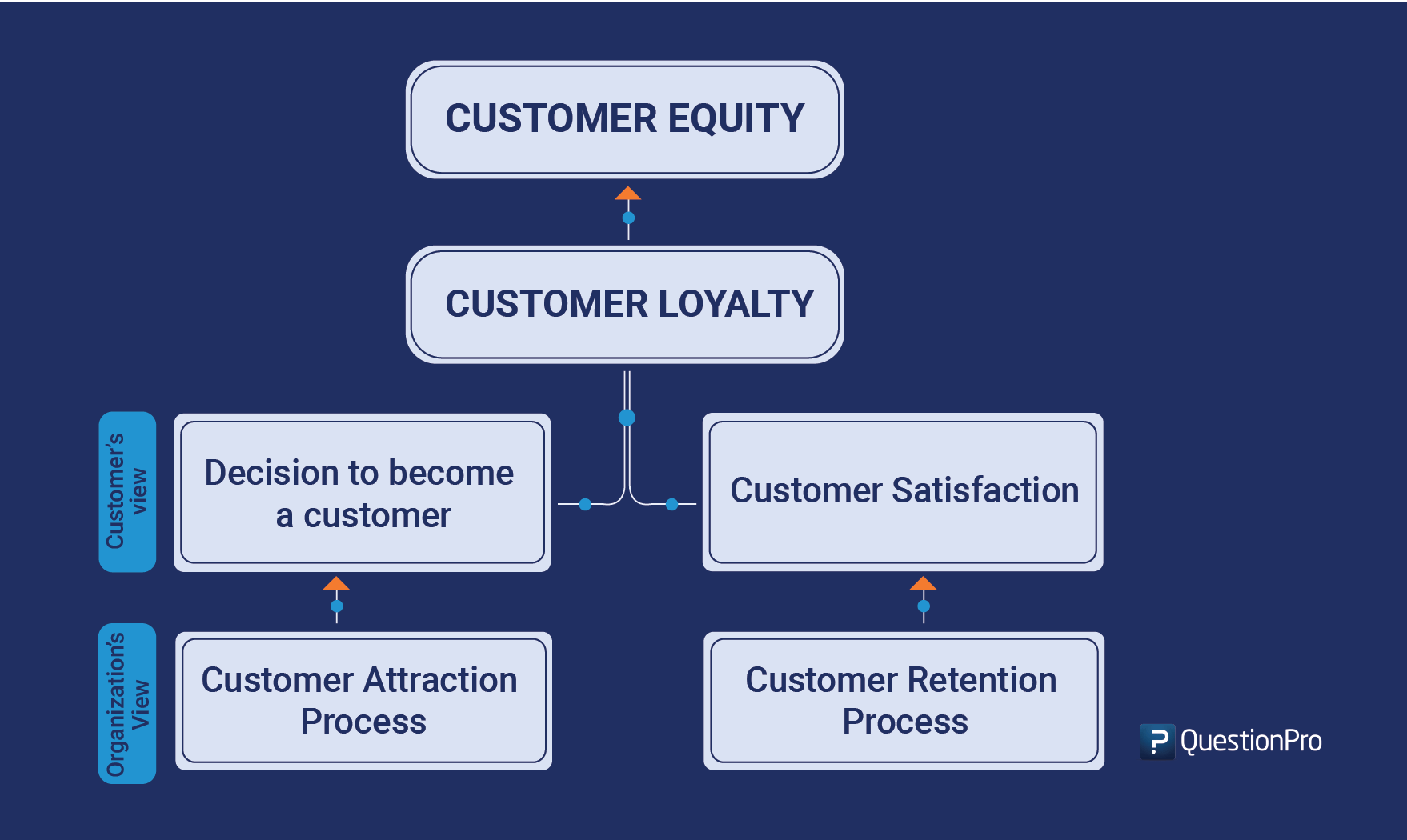Customer Equity is defined as the total of the discounted lifetime values of the organization’s customer. In short, more loyal the customers, higher is the customer equity. There are three drivers of customer equity namely: Value equity, Brand Equity, and Relationship equity.
Customer equity can be calculated using this simple formula:

Where LTV is the Lifetime Customer Value: This is the sum total of the money you expect to make from a customer. This includes cross selling and upselling.
Viral Coefficient is the number of users or referrals a user can generate for you.
To know customer equity is important because it gives you an empirical way of defining how much each customer is worth. By adding in the viral co-coefficient one can know the value a customer brings to the table over the lifetime.
The concept of customer equity encourages the organizations to consider their customers as one of the major sources of their cash flow, in present and in the future. This is the key goal of the marketing strategy that an organization follows.
Today the product life cycle is small and the customers have a variety of choices. Therefore to maintain customer loyalty the brands need to get innovative and work endlessly towards improving their customer experience.
There are various models that talk about customer equity. But these models don’t clearly explain the attributes that are involved or the components that make up for customer equity. Let us first understand a simple model that will help you understand the concept with clarity.
Now that we understand what customer equity is and what are its components, we now need to understand what is the customer equity model and how the customers and organizations perceive it.
From the organization’s point of view, any organization would start from the base i.e from customer attraction. Customer attraction is a process, where the brand communicates with the customers and makes them aware of their presence.
Once the customers know about the brand and when they have made a few purchases, customer retention becomes the top priority for the brand (if any organization or brand likes think otherwise, they are in deep trouble). Brand retention is only possible if the brand provides excellent customer experience.
From the customer’s semblance, the first question they would ask themselves is, if they want to be a customer of that brand or not. If all factors of the brand satisfy them then the buyer community slowly transforms itself to become a customer. Customer satisfaction is a crucial factor that helps brands retain their customers.
Since brand equity is a component of customer equity and the model emphasizes the importance of it, let us comprehend what brand equity is.
Brand equity refers to the total value of the brand as an asset. It is the sum total of the assets and the liability attached to a brand. Brand equity determines the customer’s relationship with the brand. Brand equity is reflected in the way the customers react to the brand.
With so many brands and choices, the consumer today buy what they need not what brands provide to them. This has not only made the brand as one of the most important assets of the company but has also made marketers to include strategies to build a strong positive brand equity.
There are 3 main components of brand equity: Brand awareness, brand loyalty, brand association.
-
Brand Awareness: The first step of the equity building process is building your brand awareness. Do the buyers know about your brand? Are they aware what your brand is associated with? These are the simple questions that can help you understand if your brand is known to the buyer market.Awareness increases the rest of the brand equity components thereby helping consumers associate with it.
-
Brand Loyalty: Who is a loyal customer? A loyal customer is the one who would not only purchase from you but also recommend you to his/her family, friends and colleague. A loyal customer is always a returning customer and is an asset to a brand. A loyal customer is not made overnight. If a customer has a smooth customer journey only then they become your loyal customers. Customer service here plays a very vital role. An excellent customer experience will yield you a loyal customer who would stick to your brand despite having options to choose from.
-
Brand Association: Brand associations are the things or characteristics consumers associate with the brand. Color, language, logo are the things that the consumers associate with the brand. Brand association can be established when the brand is proactively interacting the buyer community.There are various brands in the market who are known for their unique ways of staying in touch with their consumers. It is extremely important for the brand to develop that relationship with their consumers so that the brand knows the consumer voice: their likes and dislikes.Once the consumers associate with the brand, there are 88% chances of the consumers to go to the market and search for the brand and make a purchase immediately.
As mentioned earlier customer equity is the lifetime value of all customers and brand equity is the strength and the value of the brand that decides its worth.
Customer equity and brand equity have two things in common:
-
Both emphasize on customer loyalty towards the brand
-
Both stress upon the value that customers add to the brand.
However, conceptually customer equity and brand equity are different
-
While customer equity emphasizes more on the financial gains got from the customers, brand equity is more about the strategic issues related to managing a brand.
-
Customer equity can continue to exist without brand equity and vice versa. They might have things in common but not necessarily dependent. For example, a buyer may like both McDonald’s and Burger King, but would more often buy from McDonald's.
-
Customer equity is quantitative (number driven) whereas brand equity bends more towards the qualitative aspect (connections customers make with the brand).
Although not recommended, these two can stand apart and that’s where the distinctive differences can be seen.
Survey Software Easy to use and accessible for everyone. Design, send and analyze online surveys.
Research Suite A suite of enterprise-grade research tools for market research professionals.
Customer Experience Experiences change the world. Deliver the best with our CX management software.
Employee Experience Create the best employee experience and act on real-time data from end to end.








